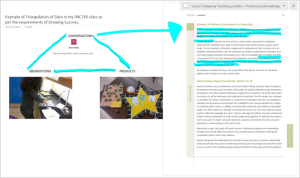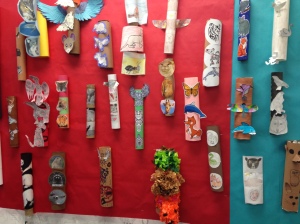- Instruction– The teacher uses research-based instructional practices to meet the needs of all students.
2.2 Engaging Students in Learning – Most activities and assignments are appropriate to students, and almost all students are cognitively engaged in exploring content.
This standard addresses student engagement in instruction. In order to meet the standard, instruction must be cognitively engaging to students. This means that the activities and assignments are at the appropriate level for student engagement so that they can explore content at the level in which they are able to comprehend the content while being challenged to expand their understanding.
In the eighth grade Social Studies class where I intern, to engage students in exploring what life was like during WWII in America, we set up a WWII museum in the library. Myself and cooperating staff gathered artifacts through the Museum of History and Industry (MOHAI) located in Seattle, as well as through the generosity of teachers and staff within our school community. By bringing the museum to the students, we were able to providing students with the opportunity to participate in a simulation of a museum experience. Because of the variety and quality of artifacts, every student was able to find a piece of the museum that deepened their understanding of the WWII era. Seeing the staff-related artifacts, students began to comprehend how many families were impacted by WWII. Students could read newspapers and magazines from the 40’s, which all described the war over seas, presented political cartoons and propaganda from that time, and depicted general American life during wartime. There was a real ration book, gas mask, victory garden manual, uniforms, pictures, medals, and flags. Information on all the artifacts were given so that students could read the context and purpose of each one.
In order to direct student attention during the WWII museum and keep them cognitively engaged, we provided a notetaker. To engage students in active learning, the notetaker employed certain macrostrategies such as summarizing and notetaking, nonlinguistic representations, questions, reflection, and cooperative learning (Barley, 2002). According to Marzano, “small chunks of content must still be actively processed by students” (2007). Therefore, to answer these questions, students picked artifacts that were the most interesting to them to comment on in order to break down the available material into smaller chunks. This allowed for student choice in which artifact to engage with on a deeper level. Students were then asked to examine the chosen artifacts using strategies consistent with the macrostrategies listed by Barley and her colleagues (2002). They described the artifact they saw, illustrated the artifact, predicted what purpose the artifact served, inferred author bias in newpapers and photographs, and asked questions for further inquiry. These prompts scaffolded the process of examining and analyzing artifacts and documents using these learning strategies.
These questions keep students cognitively engaged in the material presented. If students are either overwhelmed by the material presented or bored by it, they will disengage. Both reactions are indicative of the content material being either above or below student’s Zone of Proximal Development (McCormick, 2007). In order to lead students into learning in their ZDP, students should be directed in how to make meaningful connections between the content, skills and concepts. The prompting questions provided during this activity focus and scaffold that comprehension process, leading students to make meaningful connections between the artifacts and associated concepts, while using strategies and skills in the process. This student-centered learning experience was scaffolded appropriately, giving students ownership of their learning with adequate support.
From having this experience, I learned that a lot of preparation and communication is needed to facilitate this level of activity. Months ahead of time, faculty and staff in the school community are alerted to the museum’s future date, and asked to contribute their artifacts to the museum. It’s amazing what people will show up with! However, one must be courteous and allow for ample time for staff to find and transport these items. Communication with the MOHAI is necessary well in advance. Pick up and drop of the artifact “trunk” must be arranged. Inquiry into whether museums in the surrounding area have resources such as these is recommended as much as a year in advance. Communication with the library is fundamental as well. Librarians, if given enough time to prepare, can put up books related to the content of the museum, play music for ambiance, and prepare for an alternative schedule that day. Much goes into this rewarding experience!







